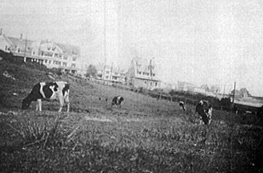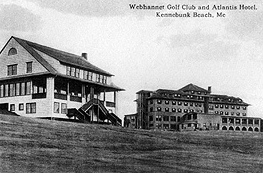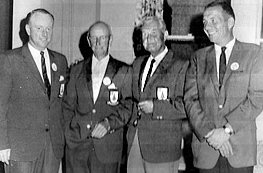History
Webhannet Golf Club nestles in the quaint Kennebunk Beach neighborhood of historic homes and seaside cottages. Set one block in from the sparkling Atlantic, the ocean air refreshes and defines this classic Maine course. Standing on the elevated sixth tee, you can literally feel the afternoon tide change and hear children's gleeful shouts as they plunge into the brisk Maine water.
Founded in 1901, Webhannet is a 6100-yard par 71 course featuring serpentine fairways, tidal-fed water hazards and undulating greens that challenge and tempt golfers of all handicaps. In June the lush fairways seem to lengthen the course by 500 yards, while late summer "roll" can yield a low score that entices you back.
Webhannet is a semi-private golf club that warmly welcomes visitors and vacationers mid-April through mid-October.
Memories Of Webhannet Golf Club - Founded In 1901
Kenneth Roberts
An early player and Kennebunk Beach resident recalls in his book "For Authors Only and Other Gloomy Essays"
"I attended the opening of this new golf course (in 1901, as a 16 year old) equipped with a brown canvas bag sparsely stocked with four clubs: a driver with a head like a cut-down hockey stick; a utensil characterized as a lofter ... with perforations in its socket so that it whistled when swung; a clumsy iron club known in those unenlightened days as a cleek and a brass-headed putter with a warped shaft.... Of the two dozen golfers who participated in the opening of our golf links in 1901, there were only a few who knew anything about the game, barring the facts that the ball was supposed to move in the general direction of the hole, and that a player should keep at least one foot on the ground when making a shot."
"Wentworth's cow pasture became a seven-hole golf course, although those who played on it might have been justified in questioning the accuracy of that definition. Only the cows, however, refused to recognize the change in the status of the pasture....At a little after four o'clock, the cows congregated on and behind the seventh green to stare hopefully over the bars that separated them from the joys of the milking hour. A golfer who holed-out without playing a carom shot from a cow was considered a fool for luck."
"While engaged in a game with Mr. Elmer Ward, then a premier golfer of Massachusetts, I was startled to discover that he clutched his putter firmly in his right hand and allowed his left hand to overlap it lightly -- a system exactly opposite to any two-handed system I had ever been advised to use. Since Mr. Ward usually sinks his last putt for 72 or thereabouts, I queried him about this use of his right hand and learned it was the grip favored by Mr. Robert T. Jones of Atlanta, who is a better putter than I am."
Henry J. (Bud) Griswoldasd
Webhannet member from 1945 until his death in 2013
"I joined the club in 1945. Webhannet had no trees! Life was slower then -- you played in shorts and the soil conditions were only so-so. I had Peter Hersey as a caddie a few times and paid him $1 or $2. Played a lot with Bill Lowell, Charles Steffens, Roger Sundham (he owned the furniture shop next to All Day Breakfast) and Ed Muskie."
"Even with only 51 members, you still needed a tee time. The beach was crowded because of all the hotels in the area, and a lot of those hotel folk liked to play golf. Canadians and other visitors came to the club -- Webhannet was hopping!"

Chester E. Homer, Jr.
Webhannet member from 1947 until his death in 2011
"I caddied at Webhannet in the mid-1930s, making maybe $3 a round. The caddie shack was an open-air shelter between the first and second fairway, near today's practice area. The caddie master would call us (me, Frank Jeune, Marlow LaBarge, Wimpy Clark and some of the Wentworth boys) up with a megaphone. We had to give him 10 cents."
"Back then in the ‘40s, donations kept the club alive. Each member chipped in maybe $100 at the end of season. The initiation fee was $25 in the ‘40s, and $90 for a golf membership. The daily fee was $4 during the week and $5 on weekends."
"The course condition back then (1940s) was not like it is today! In between the 14th and 16th fairways, there was lots of grunkle, a big mess, so if you sprayed to the right you automatically hit another ball. All they had for the course was one tractor, one mower, and that did it all. The term ‘cow pasture' comes to mind!"

Lawrence W. Ward
Webhannet member from 1953 until his death in 2014
“I was 10 when I played my first official round of golf and started caddying for my dad (Elmer Ward). One year my dad and John O. Levinson (three-time New England Amateur) played scratch here against Babe Didrikson and Gene Sarazen. John had a less-than-spectacular front 9 but Elmer kept them in the match with a commendable 37. Then, on the back, Levinson’s skills kicked in. One of the highlights was when he drove the 16th green and sank the putt.”
“Dad also became good friends with Francis Ouimet (1913 US Open winner and two-time US Amateur champion) and, consequently, I got to know Francis. In 1967 and 1968 I invited him to play in our annual Member-Guest. We were vying against Rod MacPhie and his guest in the championship flight in 1967. Even though they won, we gave them a good fight, especially on the 12th when we were one down. I hit a pretty good drive off the tee, but then I hooked my second shot into the woods on the left. It was a jungle in there. After I found my ball I could hardly see the flag, but somehow I hit it through the trees and under the pine boughs and over the telephone poles and watched it fly across the bunker and then roll along the green and drop into the cup for a birdie. Ouimet turned to me and said, ‘Lawrence, you’re a man and a half!’”
Roger S. Lawrence
Member since 1957 until his death in 2016
“The course was a bit different when I joined than it is today! The drainage was almost nonexistent so sometimes when I hit the ball from the third tee, it would literally sink into the soft muck and disappear. Never found it again. This also happened on the sixth, tenth and thirteenth fairway -- balls just vanished into the soft soil!”
“Back in the 50s, most of the members were summer people who came for a month or two. A lot of them were “Captains of Industry,” like Neville Bauman and Charles Gleason. There weren’t too many locals who were members. The initiation fee in the mid-50s was $30 -- and some of us had to think about that.”
Charles Gleason
The Annual Men's Member-Guest Tournament
Started in 1952, the tournament was named for Charles Gleason, Webhannet President from 1938-1946.
Club member Roger Lawrence recalls, "The first annual Member-Guest Tournament was held in 1952 and had two flights of eight teams per flight -- 32 players in all. The maximum handicap was 15 for those early member-guests. That didn’t sit too well with some members! I can still recall a phone call in the 60s I had from Ed Muskie in which he bemoaned that maximum!"
Through the years notables from around the world have played in this August tournament, including:
- Francis Ouimet, U.S. Open winner in 1913 and two-time U.S. Amateur champion;
- Edmund Muskie, U.S. Senator from Maine and later Secretary of State under President Jimmy Carter;
- John Levinson, three-time winner of the New England Amateur Championship and winner of the Western Open Amateur;
- Deane R. Beman, former PGA Tour Commissioner, British Amateur champion,two-time U.S. Amateur champion and winner of four PGA Tour events.






